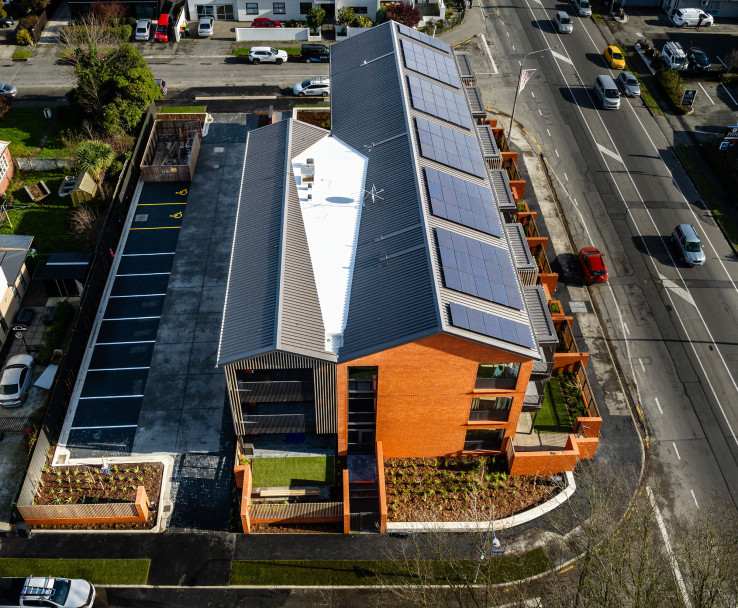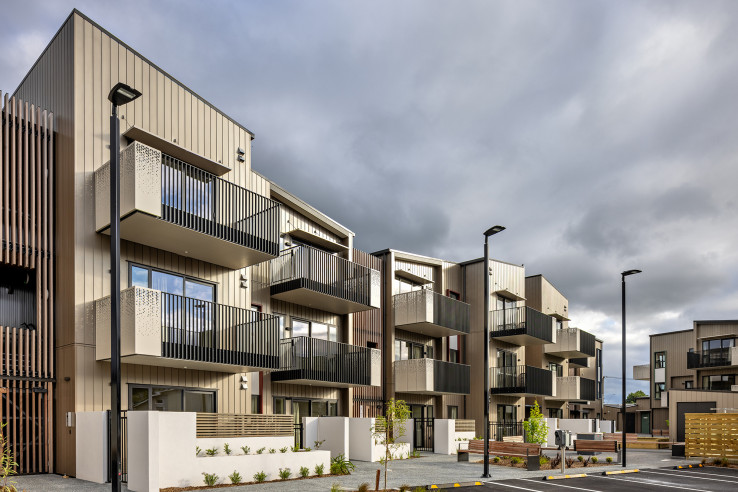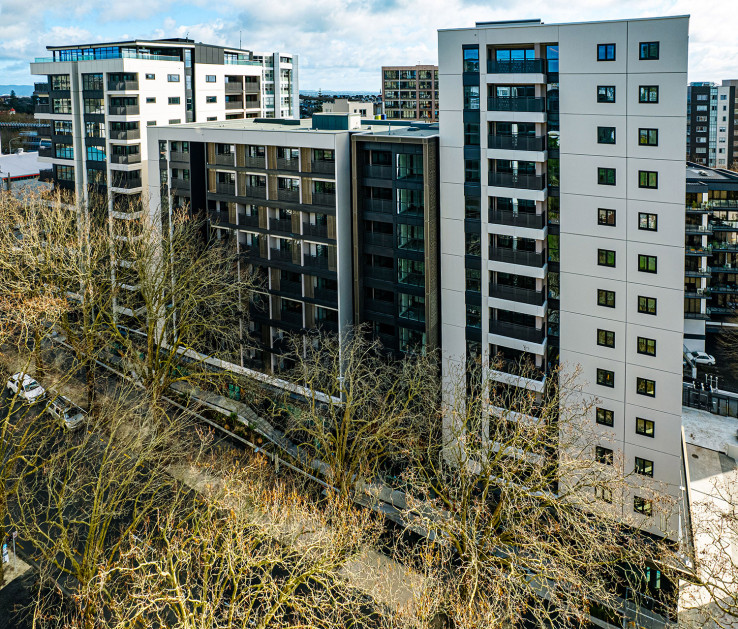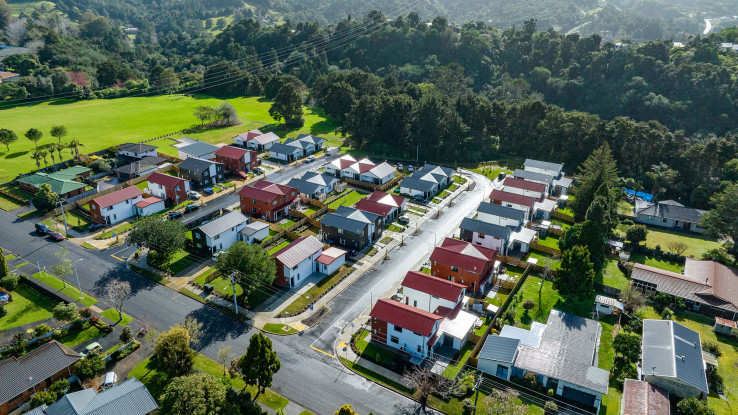“Hard to fault” Kāinga Ora developments win property industry awards
19 Sune 2024
Five Kāinga Ora social housing developments have received top accolades at the recent 2024 Property Industry Awards.
A complex at Riccarton Road, Christchurch, won the overall award in the social and affordable housing category, while developments in Lower Hutt, Māngere and Central Auckland all achieved Excellence, and a development in Whangārei received a Merit.
Hosted by the Property Council of New Zealand, the prestigious awards celebrate excellence in design and innovation in the built environment.
Patrick Dougherty, General Manager for Construction and Innovation says, “We’re proud of our work and our partnerships with the private sector. Together, we have delivered thousands of homes for so many kiwis in need of a warm, dry and safe living environment.
“Our teams work hard to deliver quality new homes throughout New Zealand – what we build needs to be adapted to a range of lifetime needs and be maintained as a government asset for over 70 years. I’m super proud of all our teams.
“We know the difference we are making in the work we do every day, but it’s always special for our mahi to be recognised and celebrated at national awards.”
Kāinga Ora manages around 74,000 homes throughout New Zealand – these are homes to approximately 190,000 New Zealanders in need, including nearly 70,000 children. By the end of June 2024, nearly 15,000 new state homes will have been built to current building code requirements and modern living lifestyles since Kāinga Ora was established in 2019.
Standing tall and elegant in red brick on 1,751m2 of land, this social housing development delivered many firsts to the community of Christchurch. Twenty new homes replaced four old state homes, the full universal design complex means people of all ages and ability can live well in their new homes.
It’s the first Kāinga Ora development in the South Island to achieve the New Zealand Green Building Council 8-Homestar rating making the homes warm and energy efficient. It has solar panels on the roof that generate electricity that is shared equally amongst residents, and five of the 20 new homes have an additional small bedroom for residents who need a carer to stay with them.
Andrew Evans, Chief Judge, Property Industry Awards, stated the project was “hard to fault”, saying “the calibre of this building has raised the bar for social housing. It resembles market quality and optimises structural design to increase operational efficiency.”
The judging panel remarked that the smarts applied to the total development process and the harmony and commitment of the team that worked on this project played a significant role in the overall success.
- The building was the first Kāinga Ora development to be installed with the Allume SolShare system which takes electricity generated by solar roof panels and shares it equally amongst residents covering 90% of residents’ day-time electricity use.
- Shared facilities include a community room with bathroom facilities on the ground floor, outdoor landscaped area with raised garden beds, mobility scooter and bike storage on each level, communal laundry and mobility charging facilities on the ground floor.
Read more about the Riccarton Road development.

This development replaced an earthquake vulnerable block with 32 new homes for the community of Lower Hutt. Sixteen of the apartments are built to full universal design so the homes can be accessed and used by a wide range of people, regardless of their age, ability or disability to live well.
Built on 2,725m2 land located close to the shops, Epuni train station and Hutt Hospital, the development also included an upgrade of public land on the Oxford Terrace and Mitchell Street corner of the site.
Shared spaces include a fully accessible community room with kitchen and bathroom, dryer room, mobility storage and charging room, outdoor communal seating and gardens with a shared garden shed, and two electric vehicle charges.
For one Kāinga Ora resident, after 20 years spent largely confined to her house, she is now moving about confidently and meeting with her neighbours in the shared community spaces, like the community room that is wheelchair accessible and opens to a garden with seats, raised gardens and washing lines.

Home to some of Auckland’s most vulnerable, this development is the first Kāinga Ora single site supported housing complex. The complex replaced an old 87-unit state housing building with 276 warm and dry new homes with 24-hour support services.
The complex is built on 6,374m2 in the heart of Auckland City and includes over 2,000m2 of communal spaces including a kitchen, dining room and recreation areas for residents, and aligns with Aotearoa New Zealand Homelessness Action Plan.
The design of the buildings and the operating model to support people in their new homes is seeing results. An excerpt from a resident’s diary offers a glimpse into what Te Mātāwai means: “As I was walking through the park, I was thinking how lucky I am to live in such a place. This is my home now. For better or worse, till death do us part. I seem to have somehow landed on my feet. It is everything I could have ever wanted or hoped for, it is perfect. I feel spoilt.”
Read more about Te Mātāwai and what one resident says its like to live there

Bader Ventura, an 18-apartment development in Māngere, is the first Passive House delivery for Kāinga Ora and the first government-funded public houses in Australasia to achieve this standard.
Completed last year, the development replaced three old, outdated homes on a 2,819m2 piece of land with a mix of two- and three-bedroom walk up apartments. All six ground-floor units are also built to full universal design standard, ensuring accessibility for people of all abilities and ages.
These were the first Kāinga Ora homes to achieve the new 7-Homestar, meaning they meet performance and sustainability requirements well beyond those of the New Zealand Building Code.
“Through Bader Ventura we’re proud to be trialing ways to improve our build programme, support customer wellbeing and help the industry build its capacity to do things differently,” says Jo Charlton Programme Director at Kāinga Ora.

This social housing development is the largest Kāinga Ora project delivered in Whangārei and sits on land that once belonged to the Ministry of Education. Recognising the opportunity to build social housing close to schools and transport routes, Kāinga Ora bought the near-vacant plot and has built 37 new terrace, duplex and stand-alone homes of between one and five-bedrooms.
Half of Puriri Park Road’s 1.7ha land is devoted to native bush, which Kāinga Ora has gifted to Whangārei District Council as a reserve that is more accessible to Whangārei locals now a new loop road has been built for public access to the reserve.
The community room with kitchen and terrace has become a hub for socialising. The community room is managed by a group of residents and has quickly become a social hub, playing host to barbecues, kids’ events and a Guy Fawkes get-together.
One neighbour initially opposed to the development contacted Kāinga Ora to say the area has been transformed, and one resident told Kāinga Ora “Living here I feel cared for. I never had that before.”
Read more from one of our residents.

Media Contact
Kuo fakafo‘ou ‘a e peesí: 19 Sune 2024
